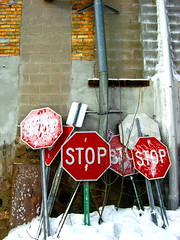Some highlights from Vanderbilt's essay:
Traffic engineers are rather obscure characters, though their work influences our lives every day. A geographic survey of East Lansing, Michigan, for example, once found that more than 50 percent of the retail district was dedicated to “automobile space”—parking, roads, and the like. By and large, the design and management of this space is handed over to traffic engineers, and our behavior in it is heavily influenced by their decisions.
“Do you really think that no one would perceive there is a bridge over there?” Monderman might ask, about a sign warning that a bridge was ahead. “Why explain it?” He would follow with a characteristic maxim: “When you treat people like idiots, they’ll behave like idiots.”
“When government takes over the responsibility from citizens, the citizens can’t develop their own values anymore,” he told me. “So when you want people to develop their own values in how to cope with social interactions between people, you have to give them freedom.”
Vanderbilt also discusses how Level of Service is described only in terms of motor vehicle travel -- any other mode of transportation is viewed only in terms of how they hinder automobile travel, and roads are designed to remove these impediments with the idea that travel can be faster and safer.
We know our roads are not absolutely safe, of course -- like Monderman predicted, the people who are treated like idiots are indeed behaving like idiots on the road. Vanderbilt contrasts this with "the improvised grass parking lots at county fairs: no stop signs, no speed limits, no markings of any kind—maybe just some kids with flags telling you where to go. But people, by and large, drive and walk in a cautious manner. There is no great epidemic of traffic fatalities at county fairs."
It's a good essay and should be of interest to anybody involved in traffic safety issues. Read it here at The Wilson Quarterly. Or better yet, buy the book


7 comments:
Interesting.
"There is no great epidemic of traffic fatalities at county fairs."
Of course not, but in that case, it's the last fraction of a mile of the trip. Traveling several miles through an improvised grass parking lot by any mode would be really slow and tedious.
I like the general concepts in the essay, but they seem suited primarily for destinations, not the entire trip. Or am I misunderstanding the concept?
I think the whole concept is oriented to urban traffic, not highway travel.
But in that context, the example of the county fair seems a bit strange.
His point about the county fair is simple: without any road or road signs, the majority of drivers still behave responsibly.
Fritz, your link to second-generation road calming should be linked. It provides other examples of why and when drivers tend to drive more cautiously and link their future with that of the young cyclists. Drivers' speed and attitudes are important factors in making STR successful.
Jack
Fritz said: "I think the whole concept is oriented to urban traffic, not highway travel."
Right, but what portion of urban traffic? Every arterial and collector? Every intersection?
Local example: The entire length of El Camino Real? Parts of it?
I like the concept, but I'm having trouble picturing an entire city's road network working like this.
Mike, the name of Monderman's concept is "Shared Space." The Wikipedia article seems like a good explanation, and from the examples it looks like something like Castro Street in Mountain View or the numbered streets in downtown San Jose between Santa Clara and San Carlos could be candidates.
Throughfares like ECR probably wouldn't be good candidates, at least not in the United States. Can you imagine the uproar if Menlo Park tried to "calm" ECR around the Santa Cruz Ave area?
That's my non-expert take on it, anyway. When I participated in traffic calming efforts it was always residential and "business district" streets, not arterial routes.
Post a Comment